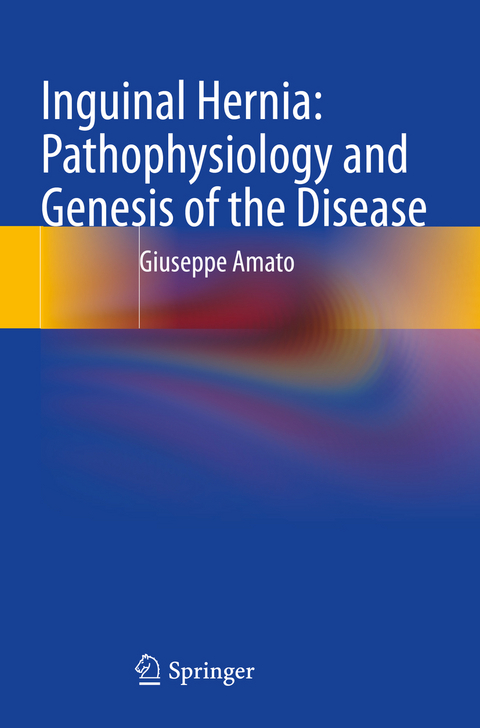
Inguinal Hernia: Pathophysiology and Genesis of the Disease
Springer International Publishing (Verlag)
978-3-030-95226-6 (ISBN)
This book aims at filling a gap in relation to the pathophysiology of the inguinal region and the genesis of groin protrusions. While inguinal hernia is a widespread disease and hernia repair accounts for the most frequently performed surgical procedure, these two aspects have been unsatisfactorily investigated, so that to date there is no shared hypothesis on how visceral protrusion through inguinal barrier occur. Exact knowledge on the pathogenesis is fundamental for adequately managing a disease, otherwise all curative approaches would not be evidence-based, but merely empirically identified and with uncertain outcomes carried out. Moreover, in absence of pathogenetic certainty, formulating guidelines simply results in an unjustified methodology harbinger of polemics and controversies. Previous studies concerning the pathogenesis of inguinal protrusions were mainly focused on the detection of biochemical changes, mostly related to collagen chains, metalloproteinase and similar elements. Nevertheless, despite decades of researches, a sure relationship between these ultrastructural modifications and visceral protrusion has not been proven. On the contrary, over the years very few investigations dealt with evidencing eventual modifications in the tissue structures of the herniated groin. An extensive research finalized to ascertain in patients and in cadavers structural changes of the tissue elements composing the groin was therefore carried out by the author and his researchers team. The findings of these studies resulted to be very useful for definitely evidencing the etiology of inguinal hernia disease. Overall, the proposed book scrutinizes and widens all emerging aspects related to pathogenesis, histology, physiology, surgical and functional anatomyof the inguinal area affected by hernia protrusion. It intends to be a reference guide to surgeons willing to better understand the structural modifications occurring in patients affected by this disease with the aim of improving treatment results.
lt;p>Prof. Giuseppe Amato graduated at the Faculty of Medicine of the University Palermo (Italy), He was a resident of the Surgical Clinic until 1978 and then moved to Germany, where worked at the Surgical Clinic of the Academic Hospital University Frankfurt in Hanau, and then at the Thoracic and Cardiovascular Clinic of the Göttingen University. In 1984 he obtained his specialization in General Surgery at the Aerztekammer Münster. Since 1987 he has been senior surgical consultant in various medical institutions in Palermo and Rome (Italy) and from 2016 to l 2020 he was Consultant Professor of Abdominal Wall and Hernia Surgery at the Postgraduate School of General Surgery of the University of Cagliari. Since 2016 he has been consultant professor at the University of Palermo. Prof. Amato has carried out experimental and research studies in physiopathology and surgery of the abdominal wall leading to the development of new therapeutic strategies and devices. Among these, he conceived ProFlor, the first 3D dynamic responsive device for inguinal hernia repair and developed the related surgical technique. Thanks to its intrinsic dynamic behavior, ProFlor achieves a fully different, regenerative, biological response compared to conventional hernia meshes. He also developed an updated concept of implants for fixation free treatment of ventral and incisional hernias: the tentacle mesh. This device, aside a fixation free deployment, grants a wider overlap of the abdominal wall allowing for sharply reduced length of procedure and postoperative complications.
Prof. Amato is a member of many scientific societies, among which the American College of Surgeons, the European Hernia Society, the Italian Society of Surgery and the Italian Society of Endoscopic Surgery and New Technologies. Prof. Amato serves as editorial board member and reviewer of renowned scientific journals and is often invited as speaker in medical congresses in Europe, USA and Asia.
Gross anatomy of the inguinal region.- The pelvis: gender related differences and its impact in visceral protrusion disease. An overview of the pelvic contour differences between male and female and its significance .-Physiology of the inguinal area.-Pathological anatomy and histology of the herniated groin..A comprehensive description of the structural changes occurring in the inguinal area.- The septum inguinalis: its role in the pathogenesis of inguinal hernia.- New aspects in functional anatomy of the groin.- Classification of inguinal hernias based on the functional anatomy of the groin.- State of the art and future perspectives in inguinal hernia repair.
| Erscheinungsdatum | 25.06.2023 |
|---|---|
| Zusatzinfo | XV, 88 p. 68 illus., 64 illus. in color. |
| Verlagsort | Cham |
| Sprache | englisch |
| Maße | 155 x 235 mm |
| Gewicht | 209 g |
| Themenwelt | Medizin / Pharmazie ► Medizinische Fachgebiete ► Chirurgie |
| Medizin / Pharmazie ► Medizinische Fachgebiete ► Notfallmedizin | |
| Schlagworte | Chronic degenerative damage • Histology of inguinal protrusions • Orthostatic visceral impact • Pathogenesis of inguinal protrusions • Septum inguinalis |
| ISBN-10 | 3-030-95226-6 / 3030952266 |
| ISBN-13 | 978-3-030-95226-6 / 9783030952266 |
| Zustand | Neuware |
| Haben Sie eine Frage zum Produkt? |
aus dem Bereich


